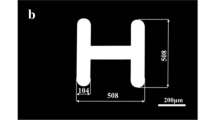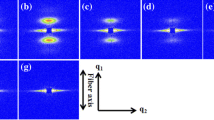Abstract
In order to research the multi-level structure of Lyocell fiber at different draw ratios and to reveal the limiting factors for preparing the high strength Lyocell fiber, the paper reports on the effect of draw ratio including low drawing (1–5), high drawing (6–11) and excessive drawing (12–20) on the multi-level structure and the mechanical properties of Lyocell fiber. The structure was determined by wide-angle X-ray diffraction, small-angle X-ray scattering and fibrillation test, and the result showed that, at low draw ratio stage, the breaking strength, yield strength and modulus of the fiber increased with the draw ratio owing to crystallinity as well as orientation increased while the micropore decreased, and there were almost no microfibrils on the fiber surface. At high draw ratio stage, the orientation of amorphous region increasing was the principal reason for the increase of fiber mechanical properties, and the micropores continued to decrease and a few short and thick microfibril was formed. At excessive draw ratio stage, the breaking strength remained constant mainly due to the basically unchanged crystallinity and orientation of the fibers, the yield strength and modulus decreased due to the slip of the highly crystallized and oriented elementary fibril. Meanwhile, the micropores still decreased and became more slender, the number of microfibrils increased and the microfibrils showed tenuous structure. It can be summarized that Lyocell fiber has the characteristics of multi-level structure, and the fundamental reason limiting the improvement of mechanical properties with draw ratio increasing is the slip of elementary fibril.










Similar content being viewed by others
References
Chen X, Burger C, Fang D, Hsiao BS, Chu B, Qi H, Zhang L (2007) Structure development in regenerated cellulose fibers wet-spun from environmentally friendly NaOH/urea aqueous solutions containing cellulose I crystals. J Biobased Mater Bio 1(2):266–273
Chen JH, Guan Y, Wang K, Xu F, Sun R (2015) Regulating effect of hemicelluloses on the preparation and properties of composite Lyocell fibers. Cellulose 22(3):1505–1516
Chen K, Yu J, Liu Y, Song M, Jiang Q, Ji H, Zou J, Zhang Y, Wang H (2019) Creep deformation and its correspondence to the microstructure of different polyester industrial yarns at room temperature. Polym Int 68(3):555–563
Colombe G, Gree S, Lhost O, Dupire M, Ivanov DA (2011) Correlation between mechanical properties and orientation of the crystalline and mesomorphic phases in isotactic polypropylene fibers. Polymer 52(24):5630–5643
Fink HP, Ganster J, Lehmann A (2014) Progress in cellulose shaping: 20 years industrial case studies at Fraunhofer IAP. Cellulose 21(1):31–51
Guinier A, Fournet G, Yudowitch KL (1955) Small-angle scattering of X-Rays. Phys Today 9(8):38
Guizani C, Nieminen K, Rissanen M, Larkiala S, Sixta H (2020) New insights into the air gap conditioning effects during the dry-jet wet spinning of an ionic liquid-cellulose solution. Cellulose 27(9):4931–4948
Hauru LKJ, Hummel M, Michud A, Sixta H (2014) Dry jet-wet spinning of strong cellulose filaments from ionic liquid solution. Cellulose 21(6):4471–4481
Jadhav S, Lidhure A, Thakre S, Ganvir V (2021) Modified Lyocell process to improve dissolution of cellulosic pulp and pulp blends in NMMO solvent. Cellulose 28:973–990
Jiang Z, Tang Y, Men Y, Enderle HF, Rieger J (2007) Structural evolution of tensile-deformed high-density polyethylene during annealing: scanning synchrotron small-angle X-ray scattering study. Macromolecules 40(20):7263–7269
Jiang G, Yuan Y, Wang B, Yin X, Mukuze KS, Huang W, Zhang Y, Wang H (2012) Analysis of regenerated cellulose fibers with ionic liquids as a solvent as spinning speed is increased. Cellulose 19(4):1075–1083
Jin H, Kumi AK, Cui S, Zhang Y (2021) Influence of carbon black with different polar groups on the solvent N-methylmorpholine N-oxide. Color Technol 00:1–9
Klug H, Alexamder L (1954) X-ray diffraction procedures. Wiley, New York
Kolpak FJ, Blackwell J (1976) Determination of the structure of cellulose II. Macromolecules 9:273–278
Mao J, Heck B, Abushammala H, Reiter G, Laborie MP (2019) A structural fibrillation para meter from small angle X-ray scattering to quantify puip refining. Cellulose 26(1):107–117
Medronho B, Romano A, Miguel MG, Stigsson L, Lindman B (2012) Rationalizing cellulose (in) solubility: reviewing basic physicochemical aspects and role of hydrophobic interactions. Cellulose 19(3):581–587
Melani L, Kim HJ (2020) The surface softness and mechanical properties of wood pulp-lyocell wet-laid nonwoven fabric. J Text Inst 112(8):1191–1198
Michud A, Hummel M, Sixta H (2016) Influence of process parameters on the structure formation of man-made cellulosic fibers from ionic liquid solution. J Appl Polym Sci. https://doi.org/10.1002/app.43718
Miyamoto H, Yamane C, Mori M, Okajima K, Sugiyama J (2009) Cross-sectional distribution of crystalline and fibril orientations of typical regenerated cellulose fibers in relation to their fibrillation resistance. Text Res J 79(8):694–701
Moriam K, Sawada D, Nieminen K, Hummel M, Ma Y, Rissanen M, Sixta H (2021) Towards regenerated cellulose fibers with high toughness. Cellulose. https://doi.org/10.1007/s10570-020-03115-8
Mortimer SA, Peguy AA (1996) The influence of air-gap conditions on the structure formation of lyocell fibers. J Appl Polym Sci 60(10):1747–1756
Mortimer SA, Péguy AA (1996) The formation of structure in the spinning and coagulation of lyocell fibers. Cell Chem Technol 30(1):71–82
Mortimer SA, Péguy AA, Ball RC (2008) Influence of the physical process parameters on the structure formation of lyocell fibres. Cell Chem Technol 30(3):251–266
Moss CE, Butler MF, Müller M, Cameron RE (2010) Microfocus small-angle X-ray scattering investigation of the skin–core microstructure of lyocell cellulose fibers. J Appl Polym Sci 83(13):2799–2816
Murthy NS, Grubb DT (2010) Tilted lamellae in an affinely deformed 3D macrolattice and elliptical features in small-angle scattering. J Polym Sci Polym Phys 44(8):1277–1286
Peng S, Shao H, Hu X (2003) Lyocell fibers as the precursor of carbon fibers. J Appl Polym Sci 90(7):1941–1947
Röder T, Moosbauer J, Wöss K, Schlader S, Kraft G (2013) Man-made cellulose fibres-a comparison based on morphology and mechanical properties. Lenz Ber 91:7–12
Rosenau T, French AD (2021) N-Methylmorpholine-N-oxide (NMMO): hazards in practice and pitfalls in theory. Cellulose 28:5985–5990
Ruland W (2010) Small-angle scattering studies on carbonized cellulose fibers. J Polym Sci Polym Symp 28(1):143–151
Sayyed AJ, Deshmukh NA, Pinjari DV (2019) A critical review of manufacturing processes used in regenerated cellulosic fibres: viscose, cellulose acetate, cuprammonium, LiCl/DMAc, ionic liquids, and NMMO based lyocell. Cellulose Cellulose 26:2913–2940
Schurz J, Lenz J (1994) Investigations on the structure of regenerated cellulose fibers. Macromol Symp 83(1):273–289
Schuster KC, Aldred P, Villa M, Baron M, Loidl R (2003) Characterising the emerging lyocell fibres structures by ultra-small angle neutron scattering (USANS). Lenzing Ber 82:107–117
Sharma A, Sen D, Thakre S, Kumaraswamy G (2019) Characterizing microvoids in regenerated cellulose fibers obtained from viscose and lyocell processes. Macromolecules 52:3987–3994
Sharma A, Wankhede P, Samant R, Nagarkar S, Thakre S, Kumaraswamy G (2021) Process-induced microstructure in viscose and lyocell regenerated cellulose fibers revealed by SAXS and SEM of acid-etched samples. ACS Appl Polym Mater 3:2598–2607
Silva RD, Vongsanga K, Wang X, Byrne N (2016) Understanding key wet spinning parameters in an ionic liquid spun regenerated cellulosic fibre. Cellulose 23(4):1–11
Su-jin K, Jinho J (2013) Effect of degree of polymerization on the mechanical properties of regenerated cellulose fibers using synthesized 1-allyl-3-methylimidazolium chloride. Fiber Polym 14(6):909–914
Wilchinsky ZW (1959) Advances in X-ray analysis. J Appl Phys 30:782–789
Yang T, Wen W, Yin G, Li X, Gao M, GuLiLiuLinZhang YLYHX (2015) Introduction of the X-ray diffraction beamline of SSRF. Nucl Sci and Tech 26(2):020101
Yuan W, Wu K, Liu N, Zhang Y, Wang H (2018) Cellulose acetate fibers with improved mechanical strength prepared with aqueous NMMO as solvent. Cellulose 25:6395–6404
Zeng J, Bian F, Wang J, Li X, Wang Y, Tian F, Zhou P (2017) Performance on absolute scattering intensity calibration and protein molecular weight determination at BL16B1, a dedicated SAXS beamline at SSRF. J Synchrotron Radiat 24(2):509–520
Zhang H, Shao H, Hu X (2010a) Effect of heat treatment on the structure and properties of Lyocell fibers. J Appl Polym Sci 101(3):1738–1743
Zhang H, Wei M, Shao H, Hu X (2010b) Effect of cellulose pulp on the properties of lyocell fiber used as tire cord. J Donghua Univ 36(5):480–486
Zhang S, Chen C, Duan C, Hu H, Li H, Li J, Liu Y, Ma X, Stavik J, Ni Y (2018) Regenerated cellulose by the Lyocell process, a brief review of the process and properties. BioResources 13(2):4577–4592
Zhang H, Shen Y, Edgar KJ, Yang G, Shao H (2021) Influence of cross-section shape on structure and properties of Lyocell fibers. Cellulose 28:1191–1201
Acknowledgments
Thanks for the support of the National Natural Science Foundation of China (51773032) and the help of Shanghai Synchrotron Radiation Facility (SSRF).
Author information
Authors and Affiliations
Corresponding authors
Ethics declarations
Conflict of interest
The author states that there are no competing economic interests.
Ethical approval
This paper does not cover studies of human participants or animals by all the authors.
Additional information
Publisher's Note
Springer Nature remains neutral with regard to jurisdictional claims in published maps and institutional affiliations.
Supplementary Information
Below is the link to the electronic supplementary material.
Rights and permissions
About this article
Cite this article
Cui, S., Zhang, Y., Liu, C. et al. The influence of the multi-level structure under high drawing on the preparation of high strength Lyocell fiber. Cellulose 29, 751–762 (2022). https://doi.org/10.1007/s10570-021-04364-x
Received:
Accepted:
Published:
Issue Date:
DOI: https://doi.org/10.1007/s10570-021-04364-x




